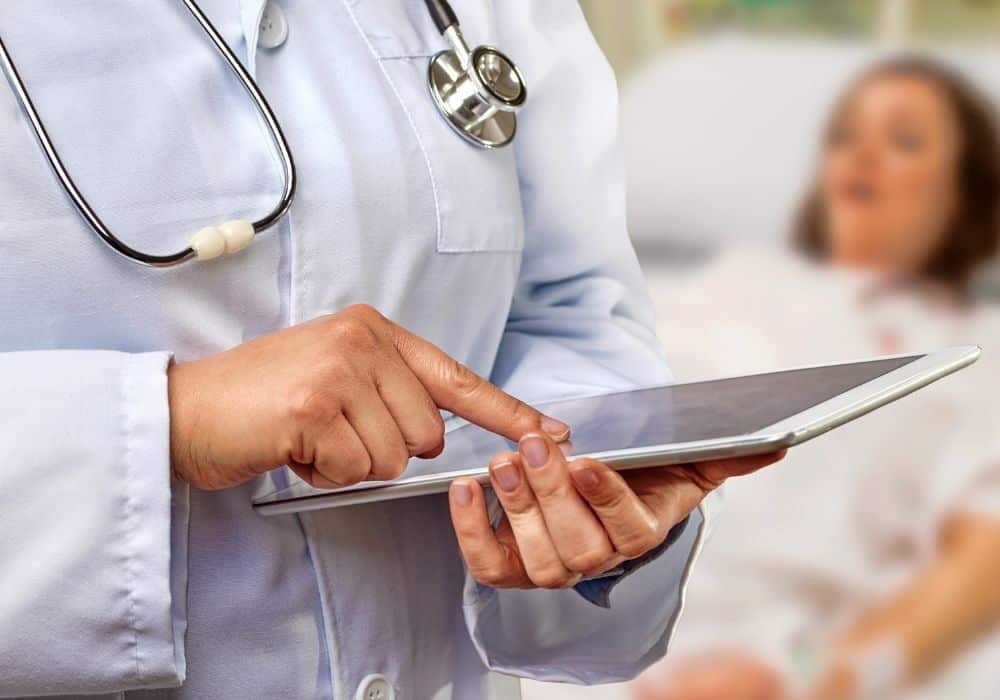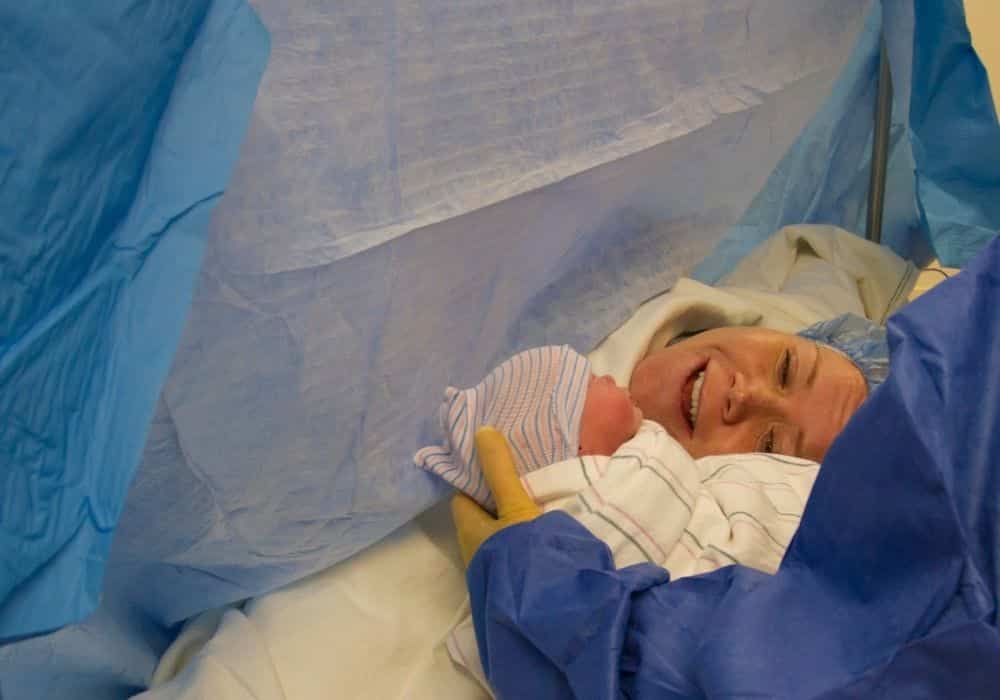As an RN who worked postpartum, I often heard the same refrain from mothers who had C-sections, “I didn’t expect it to hurt this much.”
This was true for those mothers who had unexpected C-sections as well as planned and repeat sections. The sense that I got from these mothers is that because C-sections are such common procedures (nearly 1/3 of deliveries are sections) they should be like getting a cavity filled or mole removed. Unfortunately, that is not the case. Healthcare workers are guilty of minimizing the procedure. C-sections may be common place for an OB nurse, but not for the new mama.
This procedure is a big, open belly operation, the kind of operation that we really don’t do that much of any more. Mostly, surgeons perform laparoscopic surgeries avoiding opening the abdomen unless they have to. Considering this it’s no wonder there is pain and discomfort after C-sections. Speaking in very general terms, here are some things that you can expect after your C-section. Your personal experience may vary depending on the circumstances.
ADVERTISEMENT
Burning/stinging incisional pain with tender/achy surrounding tissue.
Your nurse will undoubtedly ask you what level (on a numbered scale) you would like your pain to be at. That’s because it’s not realistic to be able to eliminate all pain. We can minimize the pain as best we can. Depending on the anesthetic block that was used during your surgery you may or may not feel discomfort for the first 12 hours or so. Some anesthetics are longer acting than others. If you start to experience breakthrough pain early on you may want to ask for a Patient Controlled Analgesia (PCA) pump. This will allow you to give yourself small doses of pain medication as needed. The pump is programmed to lock up after a certain dosage so there is no danger of overdosing.
If you make it through the first six hours or so with little discomfort you’ll probably a candidate for oral pain medication. Make sure to have a something on your stomach before taking oral narcotics. Advance your diet slowly with clear liquids, gelatin, and saltines. After tolerating these things it is safe to try oral pain medications.
During the procedure it was necessary to retract on one or both sides of your incision. This process of pulling back the muscle, adipose, and connective tissue results in the soreness, bruising, and tender muscles. Most facilities use Toradol, a powerful anti-inflammatory, for this pain. Toradol helps a lot with the tenderness and stinging pain, but it does not eliminate it altogether. Comfort measures like an ice pack or abdominal binder can help add another layer of relief. The abdominal binder is made of an elastic fabric that wraps around the waist and is secured with Velcro. It prevents stress placed on the incision from moving around in bed. Some women find binders very comforting, others do not. If you find the binder to be too tight ask your nurse to teach you how to use a pillow to splint your wound. This will help you when you cough or move about in bed. Speaking of coughing ask your nurse to teach you how to “huff cough.” This will help you to clear your lungs which is a good thing after surgery.
ADVERTISEMENT
Pain in weird places like your neck and shoulder
This is referred pain. Believe it or not it is a result of gas. It takes a little while for your GI track to resume normal functioning after surgery. This combined with narcotic pain medicine, and little movement can result in pain and discomfort. The number one way to mitigate this complication is not to wait too long to walk. There is a delicate balance of walking too much too early and not walking enough. Ask your postpartum nurse for assistance. Another mitigating factor is to progress your diet slowly. After clear liquids you may be ravenous, but I guarantee you that you’re not ready for a cheeseburger. Try eating simple carbohydrates, and proteins that are easier to digest like chicken. Overeating too early and eating the wrong kinds of fatty, fried foods can result in painful gas. Simethicone is usually available for gas, but it is not always effective in eliminating the pain. If you’re pain refers to your neck or shoulder try some gentle, topical heat, and additional walking.
ADVERTISEMENT
Regular examination of your incision site and pressing on your abdomen to feel your uterus

Your nurse will be checking your incision regularly to look for signs of infection, bleeding, and drainage. Your incision will be covered for at least the first day or so. You may notice a little staining on the dressing from drainage. Your nurse may even mark the dressing so she can better assess how much drainage you have. Your drainage may have a liquid-like slightly bloody appearance. This is normal. After the first day or so your dressing will be removed and you will be able to take a shower. Do not directly apply soap to your incision. Soap your torso and let the warm, soapy water run down your body. Pat your incision dry. If you still have some drainage you can use a peri pad to absorb it. This will also allow you to monitor your own drainage. Remember your drainage should not be yellow, green, or have a foul odor. It can look slightly bloody, but not frank bleeding. Continue to assess your incision daily looking for redness, heat, streaking, and odor.
Your postpartum nurse will routinely press on your abdomen during your assessment. She is looking for the top of your uterus, the fundus. It is important for your uterus to be firm and to begin the process of involution, returning to its normal size. Most patients have a tendency to tense up when the nurse is feeling for the fundus. Muscular tension can make the palpation more painful. Try taking several slow, deep breaths with audible exhales. This will help you relax the surrounding muscles so that your nurse can quickly and easily find your fundus.
ADVERTISEMENT
Lots of apparatus
At least initially there will be a lot of tubes and devices. You will have sequential compression devices (SCDs) on both calves to prevent blood clots in your legs. You will have a urinary catheter for the first 12 to 24 hours depending on your hospital policy. You will have an IV and fluids. You may or may not have a PCA pump for pain management. You will have a pulse oximeter measuring your oxygen saturation. If something is alarming, it’s probably this device. Try taking a few deep breaths and see if the alarm quits. If it doesn’t then it’s time to turn on your call light.
More fatigue and longer recovery

Yes, you just had a big surgery. You’re going to be tired. It takes that incision longer to heal than you thought it would. Here’s some advice. Don’t pick up anything heavier than baby. Really. Don’t do it. You need to walk around your house, but you don’t need to vacuum, dust, or do any other form of cleaning. Let it go. If someone offers to make you a meal, accept it. If you already have leftovers, freeze it. You’ll use it later. If the doctor asks if you want pain medication for home say, “Yes.” You’ll regret it if you don’t have it. Shower every day and inspect your incision for those signs of infection, i.e., redness, heat, streaking, discolored drainage, and odor. You want your incision to be well-approximated, that is, you want the edges to line up. You don’t want gaping. Anyone of these things is an immediate call to your MD.
I hate to be the bearer of bad news but sometimes repeat sections are more painful. Adhesions from the previous section(s) can result in more retraction and subsequent pain. Be ready for this with additional help at home.
Please know that just because you had one C-section it doesn’t necessarily mean that you have to have another. It is possible to have something called Vaginal Birth after Cesarean (VBAC). Not all hospitals are equipped to handle VBACs. The standard of care requires that an MD be present in the hospital the entire time that you labor. Not all hospitals have laborists or hospitalists who can monitor you 24/7. If you’re very determined to have a vaginal birth after cesarean section you will need to do your research and find the physicians and hospitals that are willing to work with you.
ADVERTISEMENT

